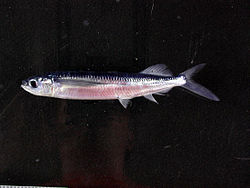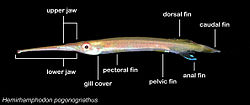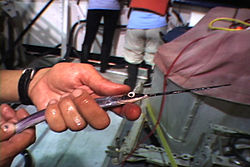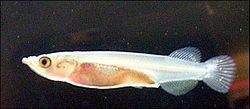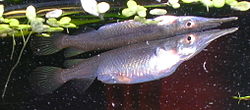
Halfbeak
Did you know...
SOS Children offer a complete download of this selection for schools for use on schools intranets. SOS Children works in 45 African countries; can you help a child in Africa?
| Hemiramphidae Temporal range: Eocene–Recent |
|
|---|---|
 |
|
| A marine halfbeak, the ballyhoo, Hemiramphus brasiliensis | |
| Scientific classification | |
| Kingdom: | Animalia |
| Phylum: | Chordata |
| Class: | Actinopterygii |
| Order: | Beloniformes |
| Suborder: | Belonoidei |
| Superfamily: | Exocoetoidea |
| Family: | Hemiramphidae T. N. Gill, 1859 |
| Subfamilies and Genera | |
|
Hemiramphinae Gill, 1859 |
|
The halfbeaks ( family Hemiramphidae) are a geographically widespread and numerically abundant family of epipelagic fish inhabiting warm waters around the world. The family Hemiramphidae is divided into two subfamilies, the primarily marine Hemiramphinae and the freshwater or estuarine Zenarchopterinae. The halfbeaks are named for their distinctive jaws, in which the lower jaws are significantly longer than the upper jaws. The halfbeaks show an exceptionally wide range of reproductive modes. These include egg-laying, ovoviviparity, and true vivipary where the mother is connected to the developing embryos via a placenta-like structure. In some of the livebearing species, developing embryos are also known to exhibit oophagy or intrauterine cannibalism, where developing embryos feed on eggs or other embryos within the uterus.
Though not commercially important themselves, these forage fish support artisanal fisheries and local markets worldwide. They are also fed upon by other commercially important predatory fishes, such as billfishes, mackerels, and sharks. Some halfbeaks are maintained as aquarium fish.
Taxonomy
In 1775, Carolus Linnaeus was the first to scientifically describe a halfbeak, Esox brasiliensis. In 1775 Peter Forsskål described two more species as Esox, Esox far and Esox marginatus. It was not until 1816 that Georges Cuvier created the genus Hemiramphus; from then on, all three were classified as Hemiramphus. In 1859, Gill erected Hemiramphidae, deriving its name from Hemiramphus, the family's type genus. The name comes from the Greek hemi, meaning half, and rhamphos, meaning beak or bill.
The family Hemiramphidae is currently divided into two subfamilies, the Hemiramphinae and the Zenarchopterinae, each containing about half the known species. A 2004 review of the family recognized two subfamilies, 13 genera, and 117 species and subspecies. More recently, Hemiramphidae lost the genus Oxyporhamphus to Exocoetidae.
The Hemiramphinae are primarily marine and found in the Atlantic, Pacific, and Indian Oceans, though some inhabit estuaries and rivers. The Zenarchopterinae are confined to the Indo-West Pacific zoogeographic region, an area running from East Africa to the Caroline Islands. The Zenarchopterinaeexhibit strong sexual dimorphism, practicing internal fertilisation, and in some cases ovoviviparous or viviparous. Three genera in this subfamily are exclusively freshwater fish and several, such as the wrestling halfbeak, have become commonly traded aquarium fish. Some authors recognize Zenarchopterinae as a separate family (Zenarchopteridae).
Evolution
The halfbeaks' fossil record extends into the Lower Tertiary. The earliest known halfbeak is Brachyrhamphus bolcensis from the Eocene at Monte Bolca, Italy. Apart from differences in the length of the upper and lower jaws, recent and fossil halfbeaks are distinguished by the fusion of the third pair of upper pharyngeal bones into a plate.
Phylogeny
|
||||||||||||||||||||||||
| Phylogeny of the halfbeaks. The halfbeak family Hemiramphidae (Zenarchopterinae + Hemirhamphinae) is paraphyletic. |
The phylogeny of the halfbeaks is in a state of flux.
On the one hand, there is little question that they are most closely related to three other families of streamlined, surface water fishes: the flyingfishes, needlefishes, and sauries. Traditionally, these four families have been taken to together comprise the order Beloniformes. The halfbeaks and flyingfishes are considered to form one group, the superfamily Exocoetoidea, and the needlefishes and sauries another, the superfamily Scomberesocoidea.
On the other hand, recent studies have demonstrated that rather than forming a single monophyletic group (a clade), the halfbeak family actually includes a number of lineages ancestral to the flyingfishes and the needlefishes. In other words, as traditionally defined, the halfbeak family is paraphyletic.
Within the subfamily Hemiramphinae, the "flying halfbeak" genus Oxyporhamphus has proved to be particularly problematic; while morphologically closer to the flyingfishes, molecular evidence places it with Hemiramphus and Euleptorhamphus. Together, these three genera form the sister group to the flyingfish family. The other two hemiramphine genera Hyporhamphus and Arrhamphus form another clade of less clear placement.
Rather than being closely related to the flyingfishes, the subfamily Zenarchopterinae appears to be the sister group of the needlefishes and sauries. These is based on the pharyngeal jaw apparatus, sperm ultrastructure, and molecular evidence. However, this hypothesis has awkward implications for how the morphological evolution of the group is understood, because the fused pharyngeal plate has been considered reliably diagnostic of the halfbeak family. Furthermore, the existing theory that because juvenile needlefish pass through a developmental stage where the lower jaw is longer than the upper jaw (the so-called "halfbeak stage") the theory that halfbeaks are paedomorphic needlefish is untenable. In fact the unequal lengths of the upper and lower jaws of halfbeaks appears to be the basal condition, with needlefish being relatively derived in comparison.
Morphology
The halfbeaks are elongate, streamlined fish adapted to living in open water. Halfbeaks range in size from 4 centimeters (1.6 in) standard length (SL) in Hemirhamphodon tengah to over 40 centimeters (16 in) SL in the case of Euleptorhampus viridis. The scales are relatively large, cycloid (smooth), and easily detached. There are no spines in the fins. A distinguishing characteristic is that the third pair of upper pharyngeal bones are anklylosed (fused) into a plate. Halfbeaks are one of several fish families that lack a stomach, all of which possess a pharyngeal jaw apparatus (pharyngeal mill). Most species have an extended lower jaw, at least as juveniles, though this feature may be lost as the fish mature, as with Chriodorus, for example.
As is typical for surface dwelling, open water fish, most species are silvery, darker above and lighter below, an example of countershading. The tip of the lower jaw is bright red or orange in most species. Small colored patches, particularly among males, are only found on the fins and the tip of the beak.
Halfbeaks carry several adaptations to feeding at the water surface. The eyes and nostrils are at the top of the head and the upper jaw is mobile, but not the lower jaw. Combined with their streamlined shape and the concentration of fins towards the back (similar to that of a pike), these adaptations allow halfbeaks to locate, catch, and swallow food items very effectively.
Sexual dimorphism
Sexual dimorphism is apparent in some species. Males of the ovovivaparous and vivaparous species all have a modified anal fin, the andropodium, similar to the gonopodium of poecilid livebearers, used to deliver sperm to the females. Although most egg laying species mate by shedding the milt externally, as is typical for bony fish, at least some practice internal fertilization: male Zenarchopterus use a modified anal fin to direct sperm into the genital opening of the female prior to spawning.
Besides modifications to the anal fin, other differences include size, coloration, and the beak's length or shape. Female Normorhamphus are much larger than males but aren't as brightly colored and have shorter beaks. By contrast, male Hemirhamphodon are larger than females, and some species, such as Hemirhamphodon pogonognathus, also have a long beard-like tassel on the end of the beak.
Range and habitat
Halfbeaks inhabit warm seas, predominantly at the surface, in the Atlantic, Indian, and Pacific oceans. A small number are found in estuaries and some species, including all the species in the genera Dermogenys, Hemirhamphodon, Nomorhamphus, and Tondanichthys are confined to freshwaters. Most species of marine halfbeaks are known from continental coastlines, but some extend into the western and central Pacific, and one species is endemic to New Zealand. Hemiramphus is a worldwide marine genus.
The freshwater halfbeaks all occur in freshwater or estuaries in the Indo-West Pacific region. There is a particularly high concentration of species on the island of Celebes.
Ecology and behaviour
Feeding
Marine halfbeaks are omnivores feeding on algae; marine plants such as seagrasses; plankton; invertebrates such as pteropods and crustaceans; and smaller fishes. For some subtropical species at least, juveniles are more predatory than adults. Some tropical species feed on animals during the day and plants at night, while other species alternate between carnivory in the summer and herbivory in the winter. They are in turn eaten by many ecologically and commercially important fish, such as billfish, mackerel, and sharks, and so are a key link between trophic levels.
The freshwater species are more predatory than the marine species, and typically orient themselves into the current and take aquatic insect larvae, such as midge larvae, and small insects, such as flies that have fallen on the surface of the water, particularly mosquitoes and spiders.
Behaviour
Marine halfbeaks are typically pelagic schooling forage fish. The southern sea garfish Hyporhamphus melanochir for example is found in sheltered bays, coastal seas, estuaries around southern Australia in waters down to a depth of 20 meters (66 ft). These fish school near the surface at night but swim closer to the sea floor during the day, particularly among beds of seagrasses. Genetic analysis of the different sub-populations of the eastern sea garfish Hyporhamphus melanochir in South Australian coastal waters reveals that there is a small but consistent migration of individuals among theme, sufficient to keep them genetically homogeneous.
Freshwater halfbeaks vary in social behaviour from open water schooling fish similar to the marine halfbeaks, as with species of Zenarchopterus, through to much more aggressive and combative fishes, as is best known from the "wrestling" halfbeaks of genus Dermogenys. These non-schoolers prefer to lurk among aquatic plants such as reeds, dead trees, and artificial structures of various types; from where they wait for small prey animals to drift by or alight on the surface, before darting from their hiding place to hunt. Notably, they feed extensively on female mosquitoes that are laying their eggs in the water, making them much better at mosquito control that species like guppies and mosquitofish that only take mosquito larvae.
Some marine halfbeaks, including Euleptorhamphus velox and Euleptorhamphus viridis, are known for their ability to jump out of the water and glide over the surface for considerable distances, and have consequently sometimes been called flying halfbeaks.
Reproduction
Halfbeaks exhibit a remarkably wide variety of reproductive modes ranging from straightforward egg-laying ( oviparity) through to various form of livebearing ( ovoviviparity and viviparity). There is a taxonomic split in this however: all Hemiramphinae are egg-layers, while many of the Zenarchopterinae are either ovoviviparous or viviparous.
Oviparity in the Hemiramphinae
Hemiramphinae species are all external fertilizers. They are usually egg-layers and often produce relatively small numbers of fairly large eggs for fish of their size, typically in shallow coastal waters, such as the seagrass meadows of Florida Bay. The eggs of Hemiramphus brasiliensis and H. balao are typically 1.5–2.5 mm (0.059–0.098 in) in diameter and have attaching filaments. They hatch when they grow to about 4.8–11 mm (0.19–0.43 in) in diameter. Hyporhamphus melanochir eggs are slightly larger, around 2.9 mm (0.11 in) in diameter, and are unusually large when they hatch, being up to 8.5 mm (0.33 in) in size.
Relatively little is known about the ecology of juvenile marine halfbeaks, though estuarine habitats seem to be favored by at least some species. The southern sea garfish Hyporhamphus melanochir grows rapidly at first, attaining a length of up to 30 cm (12 in) in the first three years, after which point growth slows. This species lives for a maximum age of about 9 years, at which point the fish reach up to 40 cm (16 in) and weigh about 0.35 kg (0.77 lb).
Viviparity in the Zenarchopterinae
The freshwater halfbeaks of the genera Dermogenys, Hemirhamphodon, and Nomorhamphus are all livebearers, that is, they produce well-developed free-swimming young. However, there is a great deal of variation in the details. Meisner and Burns identified no fewer than five distinct modes of viviparity and ovovivparity in freshwater halfbeaks:
| Type | Egg location | Superfetation (sperm storage) | Yolk sac | Maternal connection | Broods per mating | Example | Notes |
|---|---|---|---|---|---|---|---|
| 1 | ovarian follicle | No | Large | None | - | Southeast Asian populations of Dermogenys pusilla | |
| 2 | ovarian follicle | Yes | Small | via the coelomic cavity and pericardial sac | 3 | Dermogenys pusilla from Sabah and Dermogenys orientalis | |
| 3 | ovarian follicle, briefly, then along full ovary length | Yes | Small | Via expanded belly sac | 2 | Dermogenys viviparus | |
| 4 | ovarian follicle, briefly, then along full ovary length | No | Large | No | Nomorhamphus megarrhamphus, Nomorhamphus weberi, and Nomorhamphus towoetii | ||
| 5 | ovarian follicle, briefly, then along full ovary length | Yes | Small | Partial | Nomorhamphus ebrardtii | Late-stage embryos are oophagous (eating eggs and small embryos) like sharks and a few other fishes. |
As with other livebearing fish, freshwater halfbeaks produce small broods of large offspring compared with egg-laying species of similar size, with broods of around ten to twenty, typically 10–15 millimeters (0.39–0.59 in) long.
Relationship to humans
Halfbeak fisheries
Halfbeaks are not a major target for commercial fisheries, though small fisheries for them exist in some places, for example in South Australia where fisheries target the southern sea garfish (Hyporhamphus melanochir). and the eastern sea garfish (Hyporhamphus australis). Halfbeaks are caught by a variety of methods including seines and pelagic trawls, dip-netting under lights at night, and with haul nets. They are utilized fresh, dried, smoked, or salted, and they are considered good eating. However, even where halfbeaks are targeted by fisheries, they tend to be of secondary importance compared with other edible fish species.
In some localities significant bait fisheries exist to supply sport fishermen. One study of a bait fishery in Florida that targets Hemiramphus brasiliensis and Hemiramphus balao suggests that despite increases in the size of the fishery the population is stable and the annual catch is valued at around $500,000.
Gambling
They are small and generally peaceful towards other species, although males can be aggressive to one another. Dermogenys pusillius, the wrestling halfbeak, in particular fight vigorously. Battles may end in injuries. In some Asian countries gamblers bet on the outcomes, as they do with Siamese fighting fish.
In the aquarium
Some of the smaller freshwater species are kept as ornamental aquarium fish., particularly genera Dermogenys and Nomorhamphus, but also Hemirhamphodon and Zenarchopterus, less commonly.
To be kept successfully, halfbeaks require an aquarium with plenty of space at the surface. Depth is not critical, so a wide tank is better than a deep one. They are sensitive to low oxygen levels but are otherwise relatively hardy, except that they are intolerant of sudden changes in salinity, pH, hardness, or temperature. Consequently, they must be introduced to a new aquarium gently, and small but frequent water changes are best, so the water chemistry does not change suddenly. A few species, most notably Dermogenys pusillius, have traditionally been kept in slightly brackish water, though some authors aver that those found in brackish water are estuarine juveniles. Most traded species of Nomorhamphus and Hemirhamphodon prefer soft, neutral to slightly acidic, freshwater conditions.
Halfbeaks are sensitive and shocks like sudden changes in illumination can evoke frantic swimming activity. They may crash into the glass, injuring their beaks, or jump out of the tank. Such beak injuries usually heal within a few weeks. They will eat insect larvae such as bloodworms readily, as well as crustacean eggs, shrimp, fruit flies, and small pieces of chopped white fish. Halfbeaks sometimes eat flake foods as well. Some aquarists also offer them tiny pieces of algae wafer on the basis that most species are omnivorous in the wild, and so plant food probably suits them.
Halfbeaks breed in captivity, but despite being livebearers not easily. Miscarriages are common, particularly if the females are stressed (for example, by being moved to another aquarium). Once the fry have been born, the large babies eat newly hatched brine shrimp, small live foods such as daphnia, and powdered flake.
Conservation status
A small number of freshwater halfbeaks are listed in various categories on the IUCN Red List assessing their risk of extinction. None of these species are traded as aquarium fish. Most are simply rare in the wild, and consequently at particular risk from habitat destruction.
- Dermogenys megarramphus – Lower Risk, Near Threatened
- Dermogenys weberi – Vulnerable
- Nomorhamphus celebensis – Data Deficient
- Nomorhamphus towoeti – Vulnerable
- Tondanichthys kottelati – Vulnerable
- Zenarchopterus alleni – Data Deficient
- Zenarchopterus robertsi – Lower Risk, Least Concern
